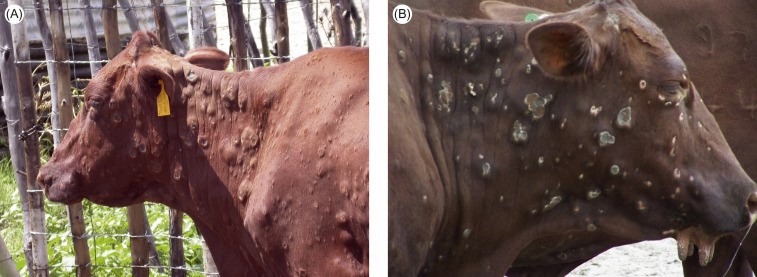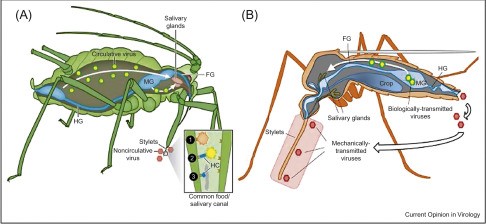
Vaccination, strict quarantine measures, limited movement of livestock along vector control could be effective for preventing the spread of the disease.
Prof Dr. Abdullah G. Arijo
Lumpy skin disease in cattle and buffalo has drawn the attention of authorities and livestock owners. Since the outbreak is for the first time, therefore a lot of questions are unanswered and confusion has created fear in public. Animal marketing has come down and the trend is on increase.
How the infection came in is a big question. As per some researchers, it spreads through mosquitoes, flies, and ticks. Sometimes through saliva and contaminated water and food. The factors determining which cattle develop mild and which develop a severe disease are unknown.
However, it may be a big surprise to know that Aedes aegypti female mosquitoes are capable of the mechanical transmission of lumpy skin disease virus from infected to susceptible cattle. Chihota and his team concluded in 2020 that mosquitoes that had fed upon lesions of infected cattle were able to transmit the virus to susceptible cattle over a period of 2–6 days post-infective feeding. The virus was isolated from the recipient animals in 5 out of 7 cases. The clinical disease recorded in the animals exposed to infected mosquitoes was generally mild, with only one case being moderate. Lumpy skin disease virus has long been suspected to be insect-transmitted, but these findings are the first to demonstrate this unequivocally, and they suggest that mosquito species are competent vectors.
The lumpy skin disease virus is one of the most important animal poxviruses because of the serious economic consequences on cattle. The World Organization for Animal Health categorizes LSD as a notifiable disease. Characterized by fever, reduced milk production and skin nodules. Mastitis, swelling of peripheral lymph nodes, loss of appetite, increased nasal discharge and watery eyes, the infection has multiple sources of transmission. Temporary or permanent infertility occur among infected cows and bulls. The disease can cause high morbidity and low mortality. Secondary bacterial infections in the affected skin lesions have been reported to increase the severity and prolong the course of the disease.
The virus is reported to show its existence and was first described in Zambia. Over the next 85 years, it spread throughout the majority of Africa and into the Middle East. In Greece in Europe, the virus entered in 2015 and Caucasus and Russia. Further, the virus spread in 2016 into the east in Balkans, north towards Moscow, and west into Kazakhstan. LSD was first reported in India in August 2019 from Mayurbhanj, Odisha. Cases of lumpy skin disease have not been reported from Pakistan until the recent outbreak in 2022.
Aedes aegypti female mosquitoes are capable of the mechanical transmission of lumpy skin disease virus (LSDV) from infected to susceptible cattle. Mosquitoes that had fed upon lesions of LSDV-infected cattle were able to transmit the virus to susceptible cattle over 2-6 days post-infective feeding. The same mosquito species is reportedly responsible to transmit yellow fever and Dengue fever in humans. Therefore, fear prevails that when humans consume meat and milk of infected cattle or buffalo, it has health issues. The Fact is that the virus is not zoonotic and doesn’t infect humans through the consumption of milk or meat. Though it affects the cow and buffalo, however, infection in the latter is minimal. However, economic losses due to lumpy skin disease are worth noting.
Molla and his team published their research in 2017 reported that the Lumpy skin disease causes considerable financial losses in the livestock industry of affected countries. A questionnaire survey with the objectives of determining direct economic losses of LSD (mortality loss, milk loss, draft loss) and treatment costs (medication and labor cost) per affected herd, and assessing the cost-effectiveness of vaccination as a means for LSD control was carried out in the central and north-western parts of Ethiopia. From a total of 4430 cattle (in 243 herds) surveyed, 941 animals (in 200 herds) were reported to be infected. The overall morbidity and mortality at an animal level were 21.2% and 4.5%, and at herd level, these were 82.3% and 24.3%. There was a significant difference in animal level morbidity and mortality between categories of animals. Over 94% of the herd owners ranked LSD as a big or very big problem for cattle production. A large proportion (92.2%) of the herd owners indicated that LSD affects cattle marketing.
Now that the infection is on an increase, and the vaccine is yet to be managed, there is a need to embark on prevention. Lumpy Skin Disease, control, and prevention depend upon four tactics namely movement control (quarantine), vaccination, slaughter campaigns, and management strategies may be considered.
Lumpy skin disease, an arthropod-borne infection is a town talk today. The concentration of infection is serious, and the movers and shakers of the livestock department are almost on alert. The Sindh CM has taken notice and instructed the authorities to provide vaccines for all cattle and has summoned a detailed report from the livestock department.
Print and electronic media are marching in cattle colony at Karachi and Hyderabad collecting diversified news that could create fear in masses with advice not to use meat and milk products. As per media reports, most cattle and buffaloes are exotic breeds in Karachi, so they have a weak immune system while local breeds have strong immune systems. This may start an un-ending blame game, hardly helping to solve the issue.
Lumpy skin disease is not new issue when it comes to Pakistan. Khan and his co-workers published their review in June 2021 “A review: Surveillance of lumpy skin disease (LSD) a growing problem in Asia” and expresses their concern with a clear note that Pakistan may be at risk.
Their review summarizes the latest developments in the epidemiology of LSD with the focus on the trans-boundary spread, possible emergence, and economic implications on Pakistan
 They were of the view that, the Lumpy skin disease (LSD) is a viral disease caused by lumpy skin disease virus (LSDV), a member of Capripoxvirus, genus of Poxviridae family. It is a trans-boundary infection of monetary significance that primarily affects water buffaloes and cattle. LSD was known to be once endemic in Saharan regions of Africa but later reported in central Asia and neighboring countries of Pakistan like, India, Iran, and China. It is a vector-borne disease and arthropods are believed to be the main perpetrators. It is discernible by its high morbidity and low mortality. Characteristic lumps on the skin and high fever are considered major signs while reduced milk production, infertility, early embryonic death, and anorexia are some of the salient clinical manifestations of the disease. Additionally, nodules on the mucosa of oro-pharynx, udder, genitalia, and rectum are usually observed on examination. This article summarizes LSD outbreaks across Asia during the last fifteen years. It is a consensus amongst the veterinary community that disease is endemic in Pakistan as it shares borders with India, Iran, and China where recent outbreaks are reported.
They were of the view that, the Lumpy skin disease (LSD) is a viral disease caused by lumpy skin disease virus (LSDV), a member of Capripoxvirus, genus of Poxviridae family. It is a trans-boundary infection of monetary significance that primarily affects water buffaloes and cattle. LSD was known to be once endemic in Saharan regions of Africa but later reported in central Asia and neighboring countries of Pakistan like, India, Iran, and China. It is a vector-borne disease and arthropods are believed to be the main perpetrators. It is discernible by its high morbidity and low mortality. Characteristic lumps on the skin and high fever are considered major signs while reduced milk production, infertility, early embryonic death, and anorexia are some of the salient clinical manifestations of the disease. Additionally, nodules on the mucosa of oro-pharynx, udder, genitalia, and rectum are usually observed on examination. This article summarizes LSD outbreaks across Asia during the last fifteen years. It is a consensus amongst the veterinary community that disease is endemic in Pakistan as it shares borders with India, Iran, and China where recent outbreaks are reported.
Historically Pakistan is free of LSD, however, it is at high risk of an LSDV outbreak as neighboring regions are becoming endemic.
Vaccination, strict quarantine measures, limited movement of livestock along vector control could be effective for preventing the spread of the disease.
Who causes Lumpy Skin Disease?
Lumpy skin disease is caused by infection of cattle or water buffalo with the poxvirus Lumpy skin disease virus. The virus is one of three closely related species within the genus capripoxvirus, the other two species being Sheeppox virus and Goatpox virus.
How is the virus transmitted?
Lumpy skin disease is primarily spread between animals by biting insects including mosquitoes and blood sucking biting flies. Besides, virus may be spread by direct contact to the skin lesions, saliva, nasal discharge, milk, or semen of infected animals.
How is lumpy skin disease treated?
Specific antiviral drugs available for the treatment of lumpy skin disease does not exist, however, the only treatment available is supportive care of victim buffalo and cattle. This can include treatment of skin lesions using wound care sprays and the use of antibiotics to prevent secondary skin infections and pneumonia. Anti-inflammatory painkillers can be used to keep up the appetite of affected animals. Intravenous fluid administration may be of benefit; however, this may not be practical in the field. The lack of treatment options for lumpy skin disease virus emphasizes the need of using effective vaccination for preventing disease.
Complete recovery from infection may take several months and maybe prolonged when secondary bacterial infections occur. A 6-month duration may be required if animals is severely affected.
Is Lumpy Skin Disease Fatal?
Lumpy skin disease is occasionally fatal disease of cattle characterized by nodules on the skin and other parts of the body.
Is vaccine against lumpy skin disease available?
Due to cross-protection within the Capripoxvirus genus, sheep pox virus (SPPV) vaccines have been widely used for cattle against lumpy skin disease virus (LSDV). In the Middle East and the Horn of Africa, these vaccines have been associated with incomplete protection and adverse reactions in cattle post-vaccination.
Vaccination of cattle is the most effective option for controlling the spread of lumpy skin disease, EFSA experts say. This is one of the main findings of a scientific statement on the effectiveness of different options for controlling the spread of this economically damaging disease.
Now that, the infection gets grip and is increasing at alarming rate, and import of vaccine may take time, therefore, the department of livestock may hamper at alarming rate may start insecticide spry for the control of biting flies and mosquitoes. To begin with this may be started from problem areas. Infected animals must also receive due attention, as the infection is contagious.
______________________
 The author is Advisor to the Vice Chancellor, Sindh agriculture University Tando Jam.
The author is Advisor to the Vice Chancellor, Sindh agriculture University Tando Jam.